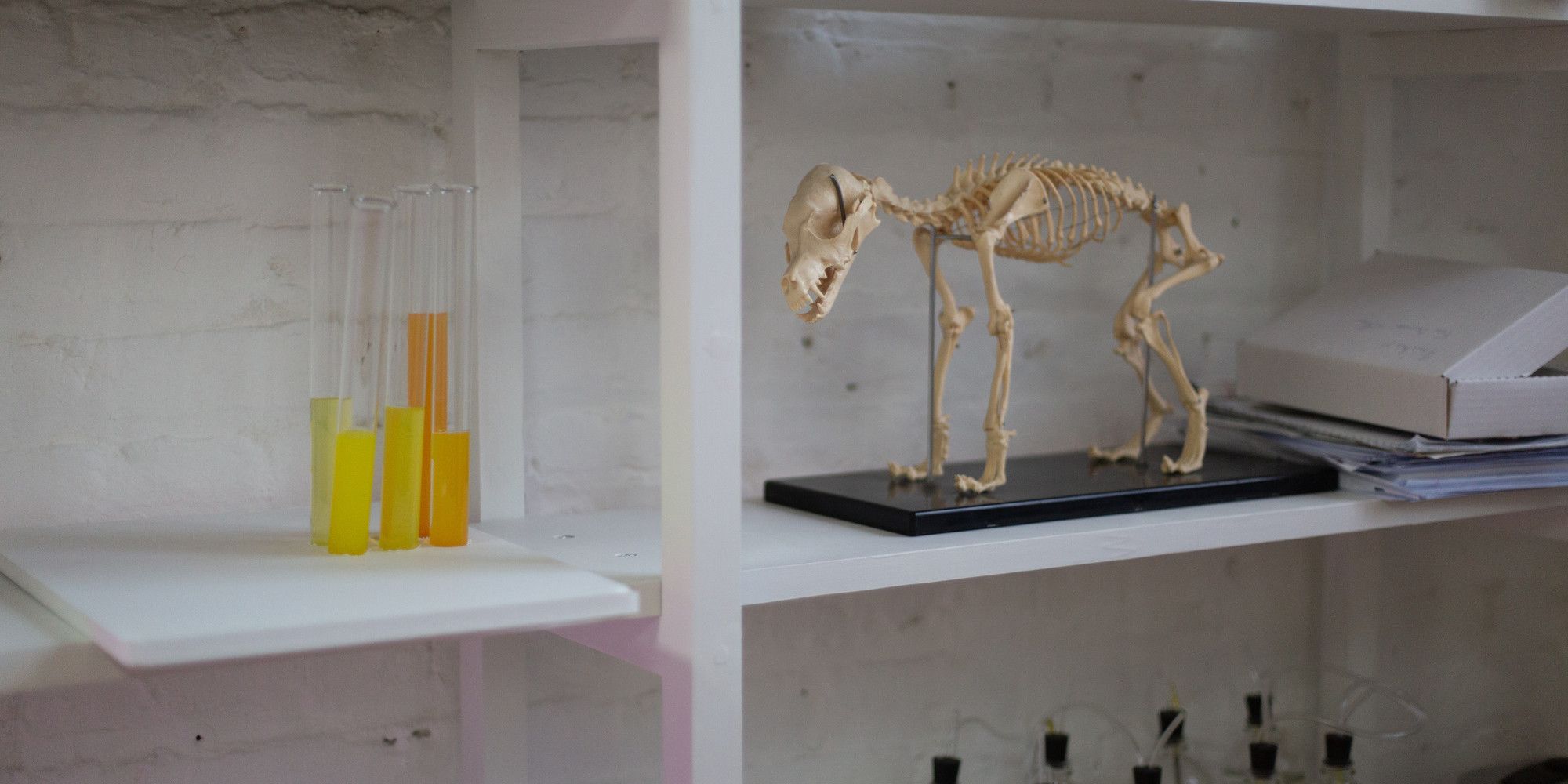
Anicka Yi
We visit the artist's studio to talk biology, philosophy, and how art can lead to scientific innovation.
Kelly Cannon, Isabel Custodio
Apr 11, 2019
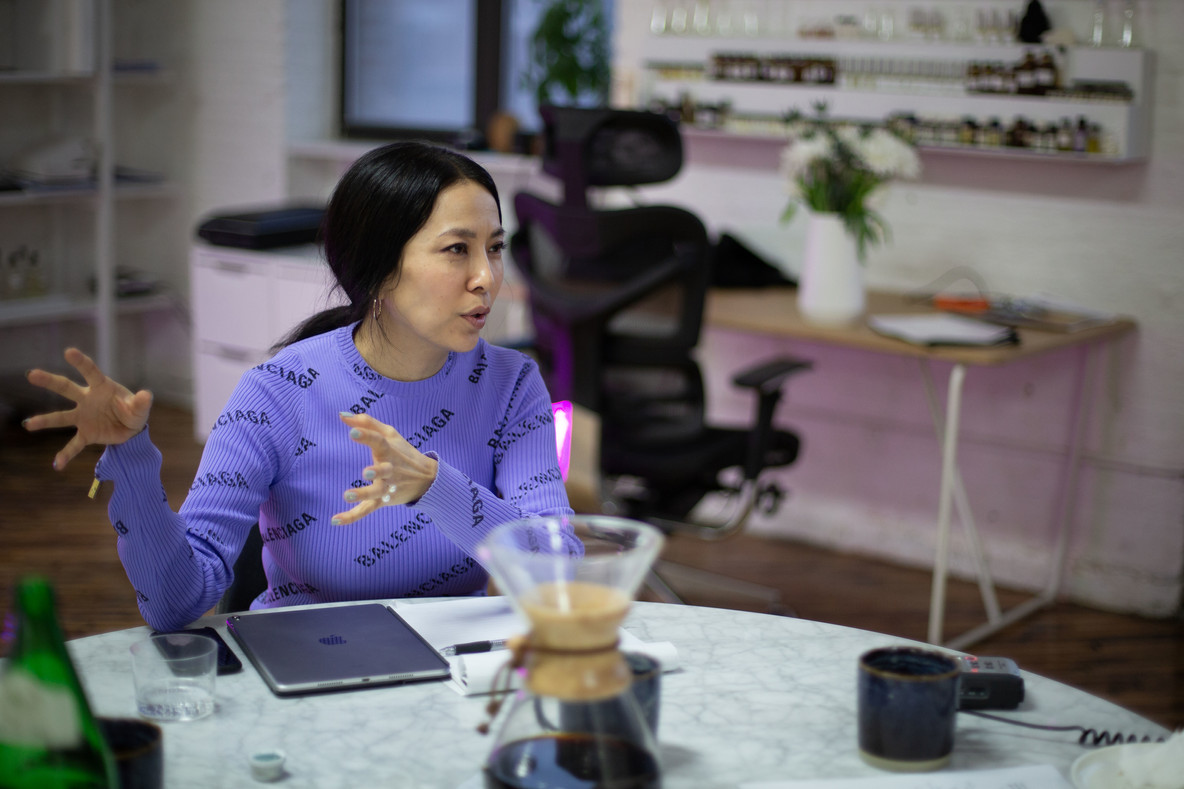
Anicka Yi. Photo: Rose Liu
Tempura-battered flowers, bacteria growing in petri dishes, a living colony of ants, diffused fragrances. Art offers a means to explore matter, space, time and perception. Anicka Yi recruits chemists, biologists and engineers to collaborate with her in making work, together defining new avenues of experience. Shameplex, now on view in New Order: Art and Technology in the Twenty-First Century, is no exception. Shameplex features seven rectangular Plexiglas boxes filled with a shallow layer of ultrasonic gel, typically used during medical ultrasounds. Nickel-plated straight pins are arranged in various geometric patterns within the gel. As time goes on, the pins begin to corrode, progressively generating a red, rusting pattern that invades the gel. Like so much of her work, Shameplex reveals the messy, if surprisingly beautiful, edges of technology and biology—the algorithms that drive the cycles of our life and sensory perceptions. As Yi says, “I think that the role of the artist is really, quite frankly, as much as a scientist, to define what life is and what life can be.”
Associate educator Kelly Cannon and content producer Isabel Custodio visited Yi’s studio to learn more about her practice, the philosophy of Shameplex, and how art can lead scientific innovation.
This interview was edited for length and clarity.
Kelly Cannon: Could you talk about how you run your studio? Do your studio assistants come with a science or an art background?
Anicka Yi: I always maintain that I don’t like an inbred intelligence; I like different kinds of intelligence. I don’t like to hire art students or people with an MFA necessarily. I’m interested in hiring people with diverse backgrounds, from engineering, biology. The way that we work here, I have four assistants and everybody has kind of a baseline role. Beyond that, everyone works together on different aspects of our project. I always tell my assistants, “There’s no fixed role here.” It’s very much reflective of a 21st-century model, which means that your skill sets are tenuous and you constantly have to pivot and transition into broader skill sets and learn difficult things.
And if that doesn’t work, you find other people who can help. We work with a lot of different cross-disciplinary platforms, whether it’s in science, textile design, holography, neuroscience, or just traditional art fabrication. We try to create a balance of things that we can manage here, and then we outsource the things that just would take up too much bandwidth for us to produce ourselves.
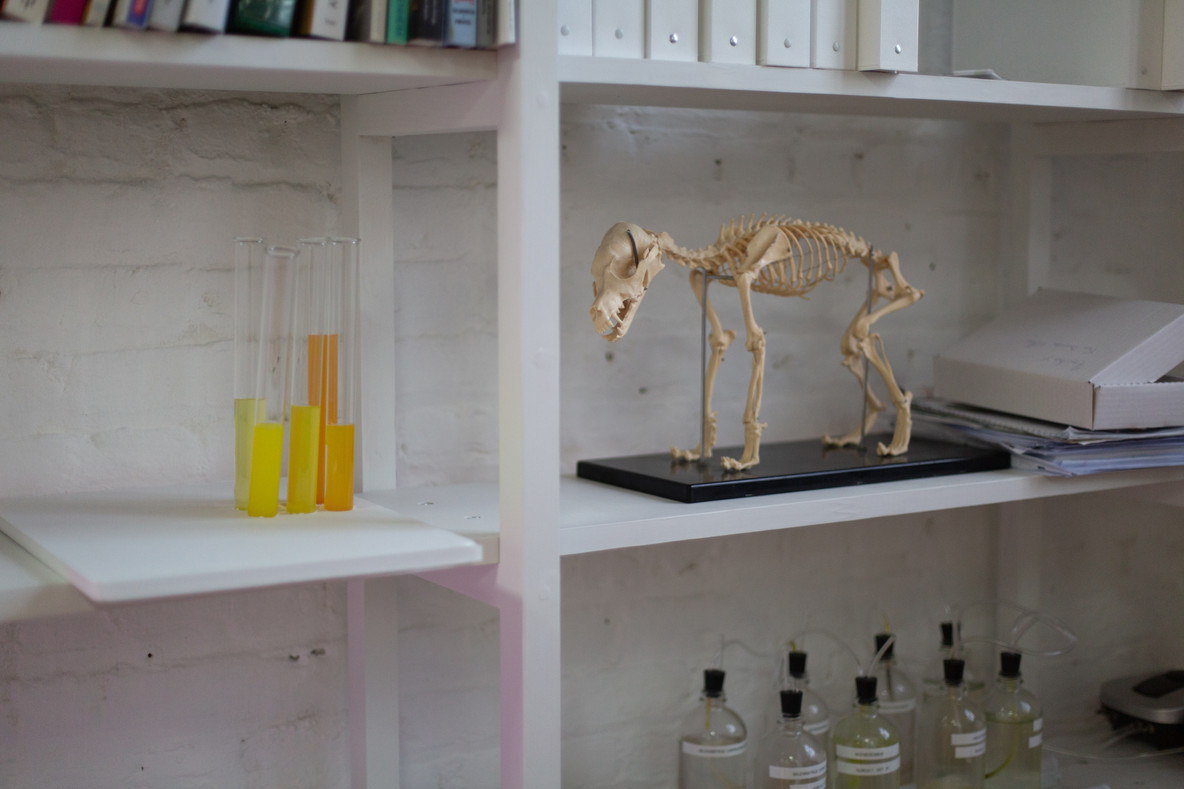
Photo: Rose Liu
Isabel Custodio: What led you to such an interdisciplinary approach?
I didn’t go to art school so I don’t have this kind of conditioning of doing things a certain way that you learn in school. I also came into art later in life as a much more developed adult. I’ve already had multiple lives in some ways, so it just felt extremely organic to pull from these different disciplines and merge them and cross-hatch and overlap, and intersect, because that’s how real life works anyway. You know, I think all artists, we all engage with science every day. It’s a matter of shifting the focus on some of the science problems that you might have, and then creating more subject matter around those issues.
KC: Could you talk about your collaborations with technologists?
It sounds really glorious, but it’s not easy because you’re dealing with actual limitations, and most of it comes down to time. A lot of people who are very highly recognized at the top of their field probably don’t have time for someone like me, realistically. I’ve had to be extremely tenacious to be able to communicate with these different fields. When I first started reaching out to scientists prior to my residency at MIT, nobody would answer my calls. I would have to stalk message boards at 2:00 in the morning at Caltech, NYU, or MIT. I would just get on some kind of thread and try to insert a question, and then I would get maybe a few answers.
I’m still recognizing that there are very different cultures going on inside the art world and the science world. There’s definitely a lot more intersectionality than there has been before. I find that a positive, but from the science perspective, that can slow things down and create a lot of reticence. One of the significant reasons for this shift is that some of the more intelligent scientists are starting to realize that, if they collaborate with artists, they can get their message out in different ways that they can’t in their own milieu. Publishing something in your latest science journal may not have the same impact as collaborating with an artist who might show at MoMA. For me, it’s about communication and it’s about being able to reach different kinds of audiences and appealing to different intelligences.
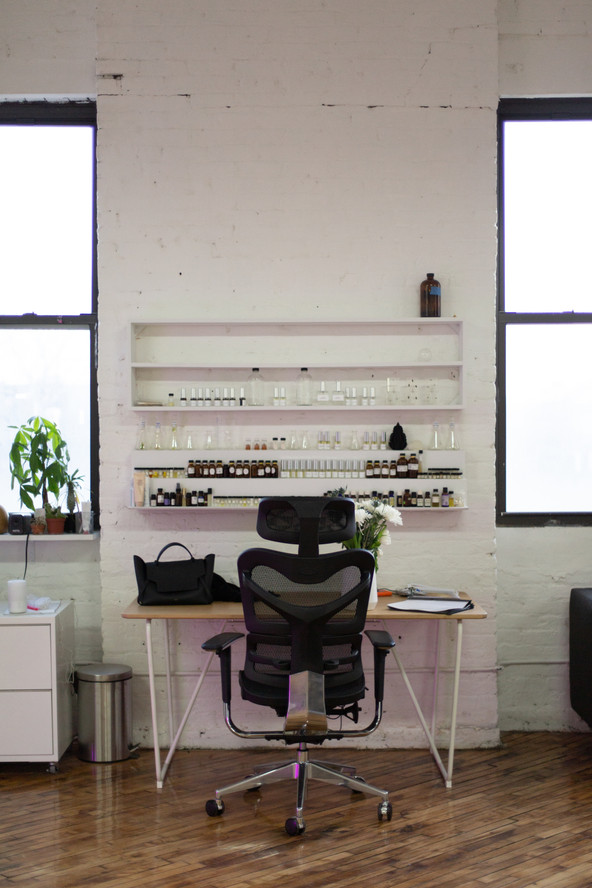
Photo: Rose Liu
KC: What do you think the role of the artist is now? How has that changed as the scope of what art is and what it looks like has also changed?
I think that the role of the artist is really, quite frankly, as much as a scientist, to define what life is and what life can be. I think that is really important. When I think about my young self, I never thought that that was art’s function. I thought art was something else, a little bit more polite. Delving further into the practice, I would go so far as to say that there is an urgency for artists to be at the table with other people who are making the important decisions about civilization as we know it, and not to take some sort of ancillary role as entertainers. Because art can actually do so much in leading the conversation. Art can actually invent tools and art can also push technology in ways that are completely unreasonable. We ask for the impossible things, the things that you’re not supposed to think. When we do that, that’s when we really start breaking new ground in terms of these other more functional, utilitarian kinds of disciplines.
IC: It seems like you’ve gone through a transition in your thinking. Is there a moment that something snapped into place for you, or has it been a gradual understanding?
It has been gradual, but I would say that the engine behind that is really fortifying the philosophy. Art for me is philosophy by different means. Building that philosophy, clarifying it, and crystallizing it made me realize, “Oh, wait, art can be this and art can function like that.” It doesn’t have to be this detachment from real life and the urgencies of the biggest questions of our time.
KC: Could you talk about how you chose the materials you used in Shameplex?
This work was produced in 2015, when I was thinking a lot about gravitating more towards this biotech intersection and how one could biologize machines. I was thinking about nested technology, how one could incubate fertilized eggs in a human womb, but then also incubate someone else’s egg, and then how that would interface with an actual ultrasound machine. The ultrasound gel transpired out of that line of thinking. I was very attracted to the viscosity. I’m very drawn toward tactile textural elements. I also wanted to impart some sort of pain, whether it’s to do with actual biological child birth or whether it’s a kind of failure of technology.
I tend to juxtapose this almost uncomfortable symbiosis and disjointed symbiosis. That came in the form of these pins that would oxidize in the ultrasound gel, and that would look like some kind of bloodletting in this pristine, clear, cool, viscous gel. Then you have these coffin-like boxes that also look like incubation. New life is growing, but something has to die. There is a lot of unintentional anguish contained inside of this vessel; it has a very mournful quality. It’s something that should bring joy, associating childbirth or being pregnant with an ultrasound gel.
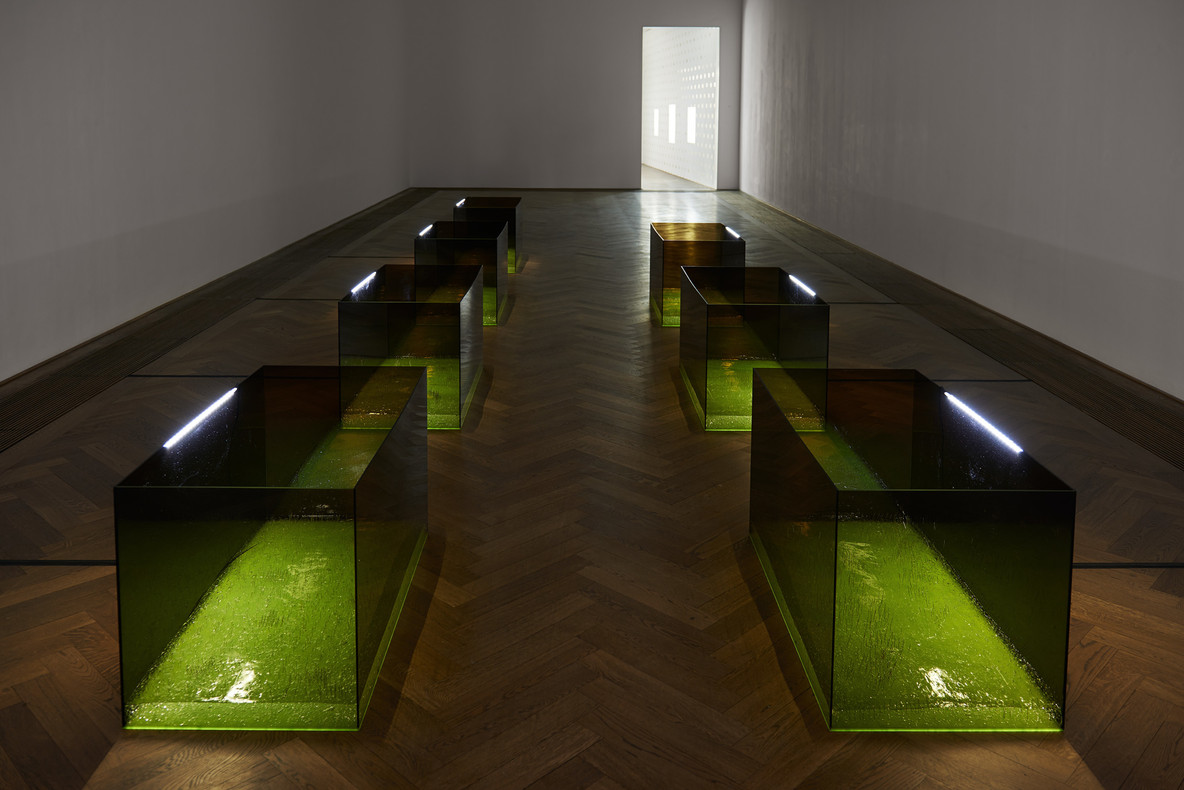
Anicka Yi. Shameplex. 2015
IC: Could you talk about the bright green bottom of the piece? Why that color?
That green just represents some kind of vertigo for me. Technology makes me kind of physically ill. It makes me dizzy. I wanted a nauseating feeling, where you would sort of recoil. It’s not pleasant. With the light, it’s not a comfortable feeling or a comfortable amalgamation, but I like it for its hideousness.
It’s funny because some people think that my work is not very technological. It’s definitely becoming increasingly so. Shameplex seems very lo-fi compared to some of the other works in [New Order]. It’s not necessarily performing as much as other algorithms or something, but there are a lot of scientists who claim that nature is a computer. We are all driven by biochemical algorithms.
KC: Can you talk about the quantity and shape of the pins?
I call them drawings inside of the boxes in the vessels. They are these almost analog drawings of something like a digital pattern. Imagine if we were to get some kind of code placed painstakingly by a human hand, but it’s like a robotic arm. In the 19th century, the 20th century, we built the factories, we built the railroads. We were the robotic arm. It’s a play on that.
IC: You’ve worked with fragrance in many of your works. How did you think about scent in Shameplex?
In relation to Shameplex, I liked that there was a kind of absence of smell. It gives you a sense that you’re in a world where smell doesn’t exist. I think that feels very radical for me. In relation to my practice as a whole, it’s a lifelong exploration. I am really interested in how we can do further research into artificial intelligence and smell. Are we going to lose smell with the rise of automated life? Does it become this inconvenient thing that we breed out of our machines? Already in humans we have diminished our capacity to activate our smell. Are we going to lose all of this sensorial intelligence? What happens? I feel that’s really important to try to translate onto machine life.
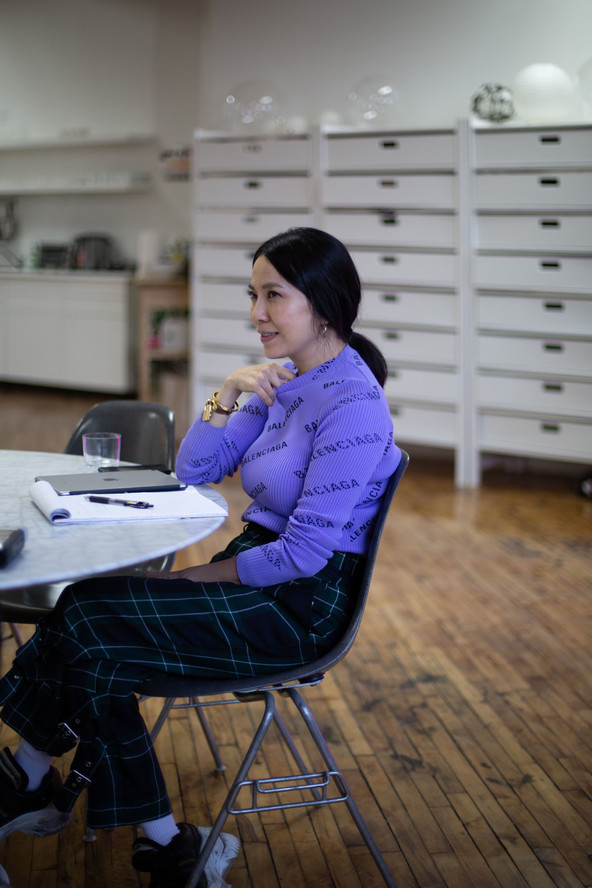
Photo: Rose Liu
KC: Do you ever consider Shameplex done, since the work is constantly changing as the rust process continues?
I don’t think any work is ever done. I know that I’m not the first artist to claim that, but especially with mine, there’s always this metamorphosis, there’s always this built-in embrace of the evolutionary process. However, at a certain point it has nothing to do with me. I shouldn’t try to steer people into how to experience it or think about it. I like talking about work, I like talking about the ideas, but when it’s out there, it’s really just up to the visitor. I’m not trying to steer my subjectivity onto everybody. I think that another area that I have a lot of trouble with is subjectivity. I’m trying to sort of dismantle my own and make it less about me.
I recognize that’s a huge—probably lifelong—project, especially with art. That whole myth about the genius, lone artist working away in some crazy studio lab and then six months later showing the world this incredibly personal, subjective, unique individual thing—I am here questioning all of it. I’m tackling a lot of ideas that I think I’ve been conditioned by, growing up in an American, Western cultural mindset and realizing, “Wow, this is not who we are.” We had a good hack for about 400 years. It’s not serving us anymore. It’s not progressive. We need a new hack. We need new ideas. We need a new vocabulary if we’re talking about our reality and where we want to go with it.
New Order: Art and Technology in the Twenty-First Century is on view through June 15, 2019, and is organized by Michelle Kuo, The Marlene Hess Curator of Painting and Sculpture, with Lina Kavaliunas, Curatorial Assistant, Department of Painting and Sculpture. Buy tickets today.
Related articles
-
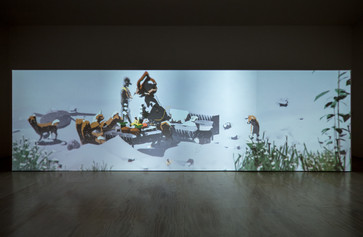
New to MoMA
Ian Cheng’s Emissaries
What do the Real Housewives, Ponyo, and The Sims have in common? They all inspired this work, newly added to MoMA’s collection.
Stuart Comer, Ian Cheng
Mar 6, 2019
-
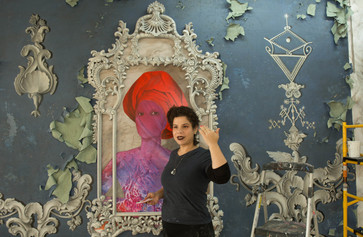
Studio Visit
Firelei Báez
Take a look inside Báez’s Bronx studio as she prepares a monument to Afro-Caribbean women for MoMA’s Modern Window.
Firelei Báez, Isabel Custodio
Nov 14, 2018

